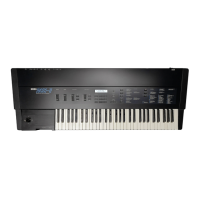Each sound is transposed up and down from its
original key value to cover the notes within its assign*
ed range. This pitch transposition is achieved by
varying the rate at which the data is read from
memory.
Since the sound data was sampled at a particular
rate (the sampling frequency) when we recorded it (or
stored it), we can change its pitch by retrieving it at a
different rate. To transpose the pitch upward, we use
a higher read-out frequency than the original sampl
ing frequency. To transpose downward, we use a
lower frequency than the original sampling frequen
cy. If we use the same frequency as the sampling fre
quency then there will be no change in the pitch. (The
same sort of thing occurs with a tape recorder if you
change the playback speed.) Note that the lower
down you transpose, the rougher you waveform
becomes— this may be an audible problem if you use
the same sound sample over a wide range.
When you assign a sound to the keyboard, you set
the original key to the same pitch (frequency) as the
originally sampled sound. Then you set the top key to
the highest note to which you want the sound's
pitch transposed. However, there is an upper "pitch
transpose limit” imposed by the highest readout fre
quency available to the DSS-1. This maximum read
out frequency is 64kHz and its relationship with the
sampling frequency is what decides how high up you
can transpose the pitch of a sampled sound. (Recall
that when you sample a sound, you have a choice of
four sampling frequencies to use. The relationship is
easy to see for the 32kHz sampling frequency. Doubl
ing the retrieval rate raised the pitch an octave.) You
can refer to the chart here when deciding where to
set the top key for each of your sounds.
Particularly when reproducing acoustic instruments,
a reliable method is to take a sample from the same
note (F for example) in each octave. Then use each
sample for one octave of the DSS-1 keyboard. In this
case, you set the original key to the same note (F) as
the sample, while the top key may be assigned a half
octave higher (B). This gives you full, smooth
keyboard coverage.
If you use fewer samples, assigning each to a wider
area of the DSS-1 keyboard, then you may notice ab
normal colorations and enveloping near the upper
and lower limits of each sound.
For high quality results it is best to use as many
samples (sounds) as possible, assigning each to a
narrow portion of the keybord, and thereby reducing
the required pitch transposition range for each
sound. This approach assures greater realism and
naturalness in the reproduced sound.
• Pitch transposition and data readout.
lower freq uency. hig her f req uency.
t ;
Pitch becomes lower. Pitch becomes higher,
(And playback time becomes longer.) (And playback time
(You also start to hear the rough edges.)+becomes shorter,)
• Interval from original key to upper pitch transpose
limit,
Sampling frequ
ency of sound.
Upper pitch
transpose Limit,
Example using C3 as original
key, showing allowable range
of top key settings.
I 6kHz
24 semitones up
(64kHz)
C 3 - C 5
24kHz
17 semitones up
(64kHz)
C 3 - F 4
32kHz
12 Semitones up
(64kHz)
i
O
\
Ü
48kHz
5 semitones up
(64 kHz)
C 3 F 3
• Example: Making a multisound reproduction of an
acoustic piano.
Sample these piano
/
-------
7
-------
7
-------
7
-------
7
-------
notes.
otct0Poi1gw o k T0P
^
------
r-';w r r
-----------------------------
. .
------------
T *
9 -
.a
------------
-----
..................
—
Sounds obtained by
sampling.
Sound assignments
and ranges.
Relationship between
original pitch and
transpose range.
Piano sound will be reproduced at the pitch
corresponding to the key played at any
point throughout the keyboard range.

